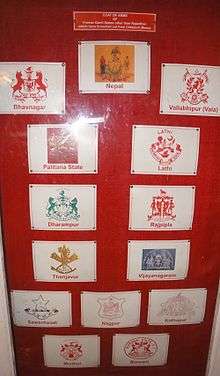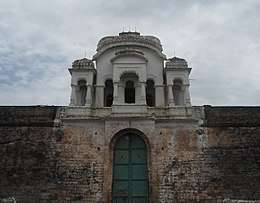Pericchedi
The Pericchedis were an ancient ruling clan in Andhra and are ancestors of the Pusapati royal family. Pericchedis built Bezawada (Modern Vijayawada) off the river Krishna in 626 and another capital in Kollipaka establishing themselves for nine centuries there. They were Kshatriyas of the Suryavanshi sect. They obtained the title of Gajapathi, after the battle of Nandapur.[1]
History
Paricchedis were staunch patrons of Hindu Dharma in contrast to the Chalukyas, who initially were patrons of Jainism.[2]
Rulers
The ancient rulers were:
- Lost genealogy
- Bhimaraja 978 Ally of the Chalukyas of Vengi
- Pandya
- Lost genealogy
- Nambaya 1 (Nambiraja) 1043 A general of the Vengi Chalukyas
- Ganda (Madalika Ganda) 1043
- Nambaya 2 1127-1131 capital in Kalipaka
- Pandyaraja 1158
- Teilokya Mallaraju 1159-1161
- Bhimaraja 1161
- Kusumaraja 1161-1230
- Bhimaraja 1230-1268
- Bhimaraja and Uttam Bhimaraja 1268-1283
- Alladanatha Devaraja and Bhimaraja 1283
- Betaraja 1265
- Kesavaraju 1292
- Suraparaja 1292
Descendants of Pericchedis



Pusapatis of Vizianagaram
(Telugu:విజయనగరం పూసపాటి వారు) The family name was changed to Pusapati after moving to the coastal region. They founded the city of Vizianagaram, named after Vijay Rama Raju, spelled with a Z to differentiate it from the Vijayanagar Dynasty in Hampi. They obtained the title of Gajapathi, after the battle of Nandapur, in the Northern Circars in the 16th century. In 1484 Pusapati Rachi Raju wrote Vasistha Gotra Kshatriya Sisa Malika.[3]
They, along with the other allies of Vijayanagar were conquered by Sultan Quli, the founder of the Qutub Shahi dynasty of Golkonda but by 1652 the 5th King of the subsequent Pusapati line was made Subahdar of the Northern Circars and they re-established themselves in the Vizagapatnam country. They received Gajapathi title after defeating the Gajapathi's of Nandapur (Orissa), their former allies and relatives, in the 16th century.[4] In 1827, Maharajah Vijay Rama Gajapati Raju III had several honors conferred on him by the British Government. Lord Northbrook obtained for him the title of His Highness, and had his name enrolled among those of chiefs entitled to return visits from the Viceroy with a 13 gun salute. A daughter was married to His Highness Maharaj Kumar Singh, cousin and heir apparent of H.H. Maharajah of Rewah. In 1848, the Maharaja of Vizianagaram visited Bezawada, the home of his family for so many centuries. His visit is recorded in a Telugu inscription.[5] A descendent of this line Sir P. Vijay Anand Gajapathi Raju inherited the family estate in Benares, married the princess of Kashipur and was a captain of the Indian cricket team in the 1930s.
- Up to 1509. The Pusapatis were ruling in Vijayawada, as that is what Vijayawada was called at the time.[6]
- Pusapati Rachi Raju (1515)[7][8] He was an ally of the Gajapathi King Rudra Deva, they were both defeated by the Vijayanagar Emperor Krishna Deva Raya. After his defeat, Krishna Deva Raya reinstated him and He and Rachi Raju married the daughters of Rudra Deva.
- Pusapati Amala Raju (Founder of the Vizianagaram branch)
- Pusapati Tama Bhupaludu (1620-1670)
- Pusapati Sita Rama Chandra Raju (ruled 1685-1697) In 1687, when Mughal emperor Aurangzeb conquered Golkonda, Sita Rama Chandra Raju obtained the Zulfikar (Two edged sword) that figures on the Pusapati flag from the emperor as a token of appreciation for having assisted him in his campaign.[9]
- Pusapati Peda Vijaya Rama Raju (Ruled 1710-died 1757) (Founder of Vizianagaram, moved the capital from Potnur) Died in the battle of Bobbili
- Pasupati Ananda Raju (died 1760) Captured Visakhapatnam and Rajamundry[10]
- Pusapati Chinna Vijaya Rama Raju (1760-1794) Died in the battle of Padmanabham against the British. Vijaya Rama Raju's brother Sita Rama Raju attacked Parlakamedi along with their Maratha allies and conquered it.
- Pusapati Narayana Babu Raju (1794-1845)
- Pusapati Vijaya Rama Gajapati Raju (1845-1879)
- Pusapati Ananda Gajapati Raju (1879-1897)
- Pusapati Vijaya Rama Gajapati Raju (1897-1922)
- Pusapati Alaka Narayana Gajapati Raju (1922-1937)
- Pusapati Vijaya Rama Gajapati Raju (1945-1995)
Other descendants of Pericchedis
The other descendants of the Pericchedis were the Alluris (Telugu:అల్లూరి ) of Chintapalli, the Kakarlapudis, who were concentrated in Nakkapalle, Srirampur, Alamanda, and Ramachandrapuram, the Mandapathis of Ponamanda, the Pinnamaraju of Kottakota, the Uppalapatis and the Valivarthis of Pajapalayam and Isukapalli's who are concentrated in Krishna district and parts of East Godavari district.
See also
Notes
- 1.^ Gajapati literally means Lord of elephants.
- 2.^ Distant relatives of this family include P.S. Kumar Swamy Raju former Chief Minister of the Madras State and P.R. Venkat Rama Raju, founder of Ramco Industries.
References
- ↑ A History of Telugu Literature. Pg. 36
- ↑ Mediaeval Jainism: With Special Reference to the Vijayanagara Empire By Bhasker Anand Saletore
- ↑ Social and Economic Conditions in Eastern Deccan from AD. 1000- AD 1250. A. Vaidehi Krishnamoorthy. 1970. Deccan India, Originally presented as the author’s thesis, Osmania University. Pg. 159
- ↑ Vizianagaram History Archived 8 March 2008 at the Wayback Machine.
- ↑ The Manual o the Krishna District. Pg. 219
- ↑ No. 45. (A.R. No. 491 of 1906.) Pulivendla, Pulivendla Taluk, Cuddapah District. On a slab set up at the entrance of the Ranganathasvamin temple. Krishnaraya, 1509. This is dated Saka 1431, Sukla, Kartika su. 12, corresponding to AD 1509, October 24, which was, Wednesday. It records a gift of the village Kunddal Kundu to the god Sri Ranga Raju of Pulivindla by Narasayya Deva Maharaju, brother of Basava Raju, son of Tamma Raju, grandson of Valla Bharaya and great-grandson of Bejawada Madhava Varma of Vasishtha-gotra and Surya-vamsa. The gift village is said to be situated in Pulivindalasthala, a subdivision of Mulkinadu in Gandhi Kotasima of Udayagiri Rajya.
- ↑ Vizianagaram Zamindars
- ↑ No. 52. (A.R. No. 18 of 1915.) Srisailam, Nandikotkur Taluk, Kurnool District. On stones built into the floor of the platform in the eastern porch of the Mallikarjuna temple. Krishnaraya, 1515. This is dated Saka 1438 (current), Yuva, Sravana su. 15, Wednesday, lunar eclipse, corresponding regularly to 25 July 1515. The king, it is stated, started out from Vijayanagara on a campaign of conquest towards the east, conquered at a stretch Udayagiri, Addanki, Vinukonda, Bellamkonda, Nagarjunikonda, Tangedu, Ketavaram and other hill-forts and land-forts and captured Tirumala Kataraya Mahapatra. Having taken Kondavidu, he captured alive Virabhadra Raya, Nara Hari Deva, Rachuri Mallukhanu, Uddandakhanu, Jannala Kasavapatra, Pusapati Rachiraju, Srinatha Raju, Lakshmipati Raju, Paschima Balachandra Mahapatra and others. Later he reinstated the captives in their places, visited Amaresvara at Dharanikota and performed the Tulapurusha ceremony in the presence of the god on the banks of the river Krishnaveni. He had the Ratnadhenu and Sapta Sagara Mahadanas performed by his queens Chinna Devi and Tirumala Devi respectively. Finally he visited Sriparvata, where he had the mandapa built in the car street of the temple.
- ↑ (India), Andhra Pradesh (2000-01-01). Andhra Pradesh District Gazetteers: Vizianagram. Director of Print. and Stationery at the Government Secretariat Press; [copies can be from: Government Publication Bureau, Andhra Pradesh].
- ↑ Francis, W. (2002-01-01). Gazetteer of South India. Mittal Publications.
